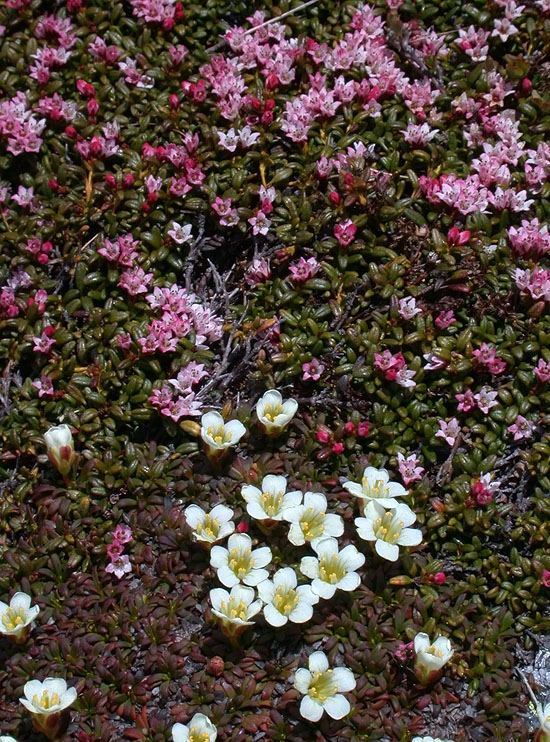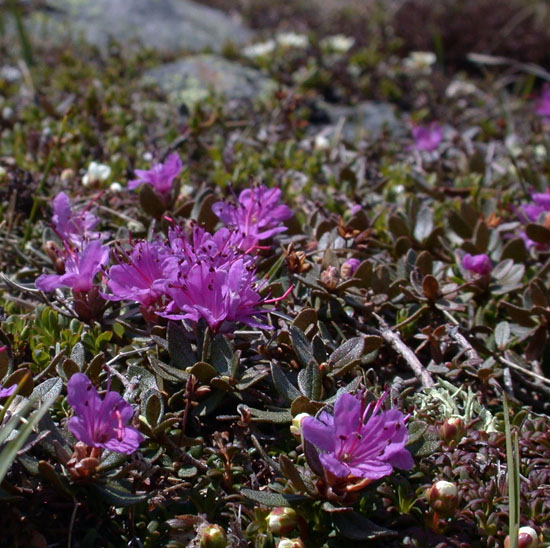Yesterday I visited Mount Washington, NH to see several alpine plants in bloom. The auto road was originally scheduled to be closed for paving but fortunately the work was done early and they decided to open at 9:30 am. Even more fortunate, as I got there early, the road was opened a little after 8:30 am.
While I was waiting for the road to open I took a walk around the visitor center. In a small rocky brook I found twisted sedge (Carex torta) which I had not seen before with mature perigynia. Notice the black-margined scales and somewhat dropping lower spike.

On a hillside meadow there was lots of bunchberry (Cornus canadensis) in bloom. Here in central NY bunchberry is not so common and rarely grows out in the open like this.

Little bluet (Houstonia caerulea) was also abundant. These could be seen everywhere from 2000′ elevation all the way up to the alpine zone, though they became less abundant further up the mountain.

In a few spots along the roadside, including just below the summit, was mountain shadbush (Amelanchier bartramiana). Unlike most other Amelanchier spp. this one has nearly sessile leaves that taper towards the base and flowers borne singly or in few-flowered clusters.

Before leaving the tree line I got the chance to see lots of mountain paper birch (Betula cordifolia). It is quite similar to, and used to be considered a variety of paper birch (Betula papyrifera). It differs from the latter in having leaves that are more or less cordate at the base and bark with a pinkish hue.

Pinkish-brown peeling bark of heart-leaved paper birch.

As the forest transitioned to krummholz (a zone of dwarfed, deformed trees) I started to find black crowberry (Empetrum nigrum) along the road. Close examination of several patches of crowberry turned up at least a little purple crowberry (Empetrum atropurpureum) which has twigs covered by white hairs unlike the smooth twigs of black crowberry.

Also in the krummholz and lower alpine zones there were alpine bilberries (Vaccinium uliginosum) just beginning to bloom.

Once I reached the summit I hiked down to the Alpine Garden Trail where boulder fields and bedrock were still covered by a bit of snow. The dwarfed and twisted evergreens are likely balsam fir (Abies balsamea) and/or black spruce (Picea mariana). The bit of lavender in the foreground are the flowers of Lapland rosebay (Rhododendron lapponicum) and the creamy white flowers are those of pincushion plant (Diapensia lapponica).

I was able to tentatively identify a few graminoids simply because of their abundance in the alpine zone despite the fact that most had not yet started to flower. These are likely the leaves of Bigelow’s Sedge (Carex bigelowii).

I was able to identify this plant as a rush since some still had fruits from last year. It is probably highland rush (Juncus trifidus) since it was rather abundant in the alpine zone.

Tufted clubsedge (Trichophorum cespitosum) was the only graminoid close to flowering. The related alpine cotton-grass (Trichophorum alpinum) is occasionally found in rich fens in central NY.

There were a few little rivulets running through the alpine zone. Near one of these the coppery-red leaves of squashberry (Viburnum edule) were just starting to emerge.

At least one willow was also associated with the rivulets. I think this one is tea-leaved willow (Salix planifolia) because it has yellowish styles. This species is known to hybridize with Labrador willow (S. argyrocarpa) on Mount Washington.

The ground-hugging bearberry willow (Salix uva-ursi) was also blooming in the alpine zone.

Ligonberry (Vaccinium vitis-idaea) was quite common in the alpine zone. A few plants still had fruit from last year. Some were close to but not quite flowering.

I was also hoping to find the endemic mountain avens (Geum peckii) in bloom but had to settle for leaves and a few immature flower stalks. This rare plant is only found in the White Mountains of NH and a few sites in Nova Scotia.

The mountain avens above is growing through a patch of Diapensia. Here is more Diapensia which was in full bloom and quite abundant in the alpine garden.

Alpine azalea (Kalmia procumbens) was found growing in close association with Diapensia. The genus Kalmia, named for famed botanist Peter Kalm, includes the mountain laurel (K. latifolia), sheep laurel (K. angustifolia), and bog laurel (K. polifolia).

Closeup of the flowers of alpine azalea.

The term azalea is typically applied to some members of the genus Rhododendron. Two Rhododendron spp. can be found in the alpine zone on Mount Washington, Labrador-tea (R. groenlandicum) which was not blooming yet, and Lapland rosebay which was just starting to bloom when I was there.

On my way back down Mount Washington I spotted another Rhododendron growing on a rock outcrop right next to the road. This one was Rhodora (R. canadense). A search of the area turned up a few more plants along a stream and some taller ones growing in a wet meadow.
